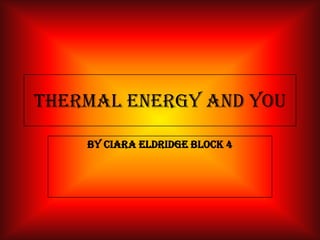Thermal Energy And You
•Download as PPTX, PDF•
2 likes•1,363 views
Report
Share
Report
Share

Recommended
Recommended
More Related Content
What's hot
What's hot (20)
Viewers also liked
Viewers also liked (11)
كن معتمدا دوليا واحصل على شهادتك باععتماد البورد الكندي للتقييم المهني من مص...

كن معتمدا دوليا واحصل على شهادتك باععتماد البورد الكندي للتقييم المهني من مص...
2012 topic 4.3 intermolecular forces and physical properties

2012 topic 4.3 intermolecular forces and physical properties
Properties of Compounds - Ionic, Covalent and Metallic

Properties of Compounds - Ionic, Covalent and Metallic
Similar to Thermal Energy And You
Similar to Thermal Energy And You (20)
Recently uploaded
Mehran University Newsletter is a Quarterly Publication from Public Relations OfficeMehran University Newsletter Vol-X, Issue-I, 2024

Mehran University Newsletter Vol-X, Issue-I, 2024Mehran University of Engineering & Technology, Jamshoro
APM Welcome
Tuesday 30 April 2024
APM North West Network Conference, Synergies Across Sectors
Presented by:
Professor Adam Boddison OBE, Chief Executive Officer, APM
Conference overview:
https://www.apm.org.uk/community/apm-north-west-branch-conference/
Content description:
APM welcome from CEO
The main conference objective was to promote the Project Management profession with interaction between project practitioners, APM Corporate members, current project management students, academia and all who have an interest in projects.APM Welcome, APM North West Network Conference, Synergies Across Sectors

APM Welcome, APM North West Network Conference, Synergies Across SectorsAssociation for Project Management
Recently uploaded (20)
Measures of Dispersion and Variability: Range, QD, AD and SD

Measures of Dispersion and Variability: Range, QD, AD and SD
Seal of Good Local Governance (SGLG) 2024Final.pptx

Seal of Good Local Governance (SGLG) 2024Final.pptx
Z Score,T Score, Percential Rank and Box Plot Graph

Z Score,T Score, Percential Rank and Box Plot Graph
Presentation by Andreas Schleicher Tackling the School Absenteeism Crisis 30 ...

Presentation by Andreas Schleicher Tackling the School Absenteeism Crisis 30 ...
APM Welcome, APM North West Network Conference, Synergies Across Sectors

APM Welcome, APM North West Network Conference, Synergies Across Sectors
Unit-IV; Professional Sales Representative (PSR).pptx

Unit-IV; Professional Sales Representative (PSR).pptx
Thermal Energy And You
- 1. Thermal Energy and You By Ciara Eldridge Block 4
- 2. What it Thermal Energy? • The dictionary definition of Thermal Energy would be considered “Total Kinetic Energy of the System.”
- 3. Wait?! What’s Kinetic Energy? • Kinetic energy is the energy of motion. How much you have depends on the mass and speed of a substance. Thermal Energy refers to the Kinetic Energy of the microscopic particles(molecules). The Higher the temperature the faster the particles.
- 4. You mentioned temperature, like how hot something is, right….? • Not exactly. Temperature is basically the average kinetic energy a substance obtains. • No, this is not considered “how hot.” Heat is in this context a verb and is the act of transferring Thermal Energy.
- 5. Are there different types of heat transfer?? • Yes only 3, Conduction, Convection, and Radiation.
- 6. Conduction?? • This is the transfer of thermal Energy by direct contact. ( or the transfer of energy through matter from particle to particle). • Examples: Touching a stove and being burned • -Ice cooling down your hand • -Boiling water by thrusting a red • -hot piece of iron into it • Hugging another and getting heated and hot after a while.
- 7. Convection?? • Convection is the transfer of thermal energy from the movement of molecules. • Examples: Warm, rising air (thermals) due to heat rising from the earth. As the warm air rises, cool air comes in from the sides to take its place. This sets up a circulating flow of air. Also, watch a glass beaker of boiling water over a not-too-high Bunsen flame, or see a pan on the stove. Note the water is rising and falling in a circular manner.
- 8. Radiation?? • Radiation is the transfer of heat from waves(Electromagnetic ). • Examples: A microwave. It sends out microwaves which radiate the water molecules in the object in the microwave and excite them and that's why the object will get hot. • visible light • infrared or ultraviolet
- 9. So…How Do I Know How Much Thermal Energy I Have? • There is the total thermal energy equation of course. • (Tf-Ti)t . (mass)(Cp) • Tf-Ti (Temp. Final – Temp. Initial)is the change in temperature in your data • T is temperature • Cp is the Specific heat Capacity • “.” Is multiply
- 10. The Process of Losing and Gaining • There are two changes to thermal energy: Endothermic change and an Exothermic change.
- 11. Endothermic Change • This is a change in which energy is aborbed. • The substance takes in energy and the molecules move faster as result. • Examples: Ice cream gains energy and therefore thermal energy and proceeds to melt.
- 12. Exothermic Change • This is a change in which energy is released. • The substance loses energy and the particles move slower as a result. • Example: The Atomic bomb explodes and releases energy.
- 13. END! • YOU NOW KNOW ALL THE BASICS OF THERMAL ENERGY~~~~~~!!!!!!!!!!!!!!!!!!!!!!!!!!!!!!!!!!!!!!! !!!!!!!!!!!!!!!!!!!!!!!!!!!!!!!!!!!!!!!!